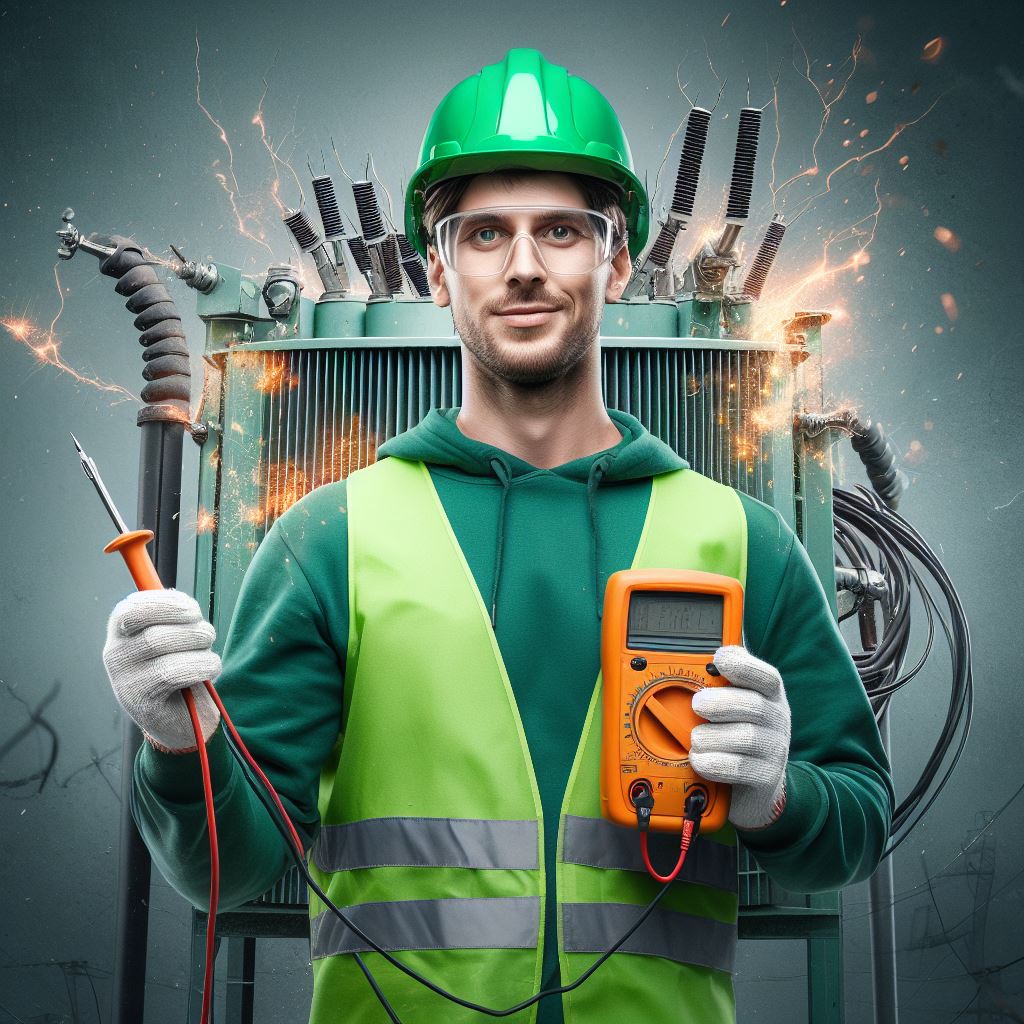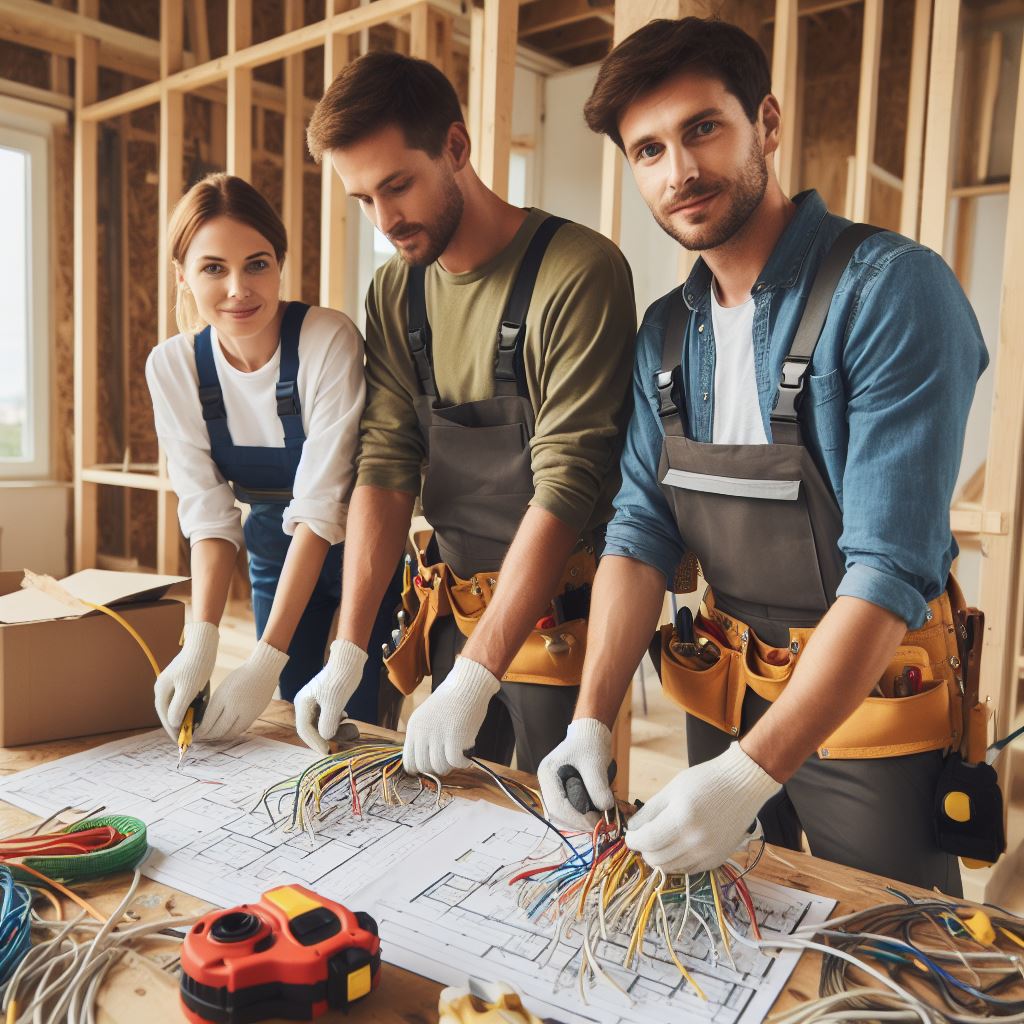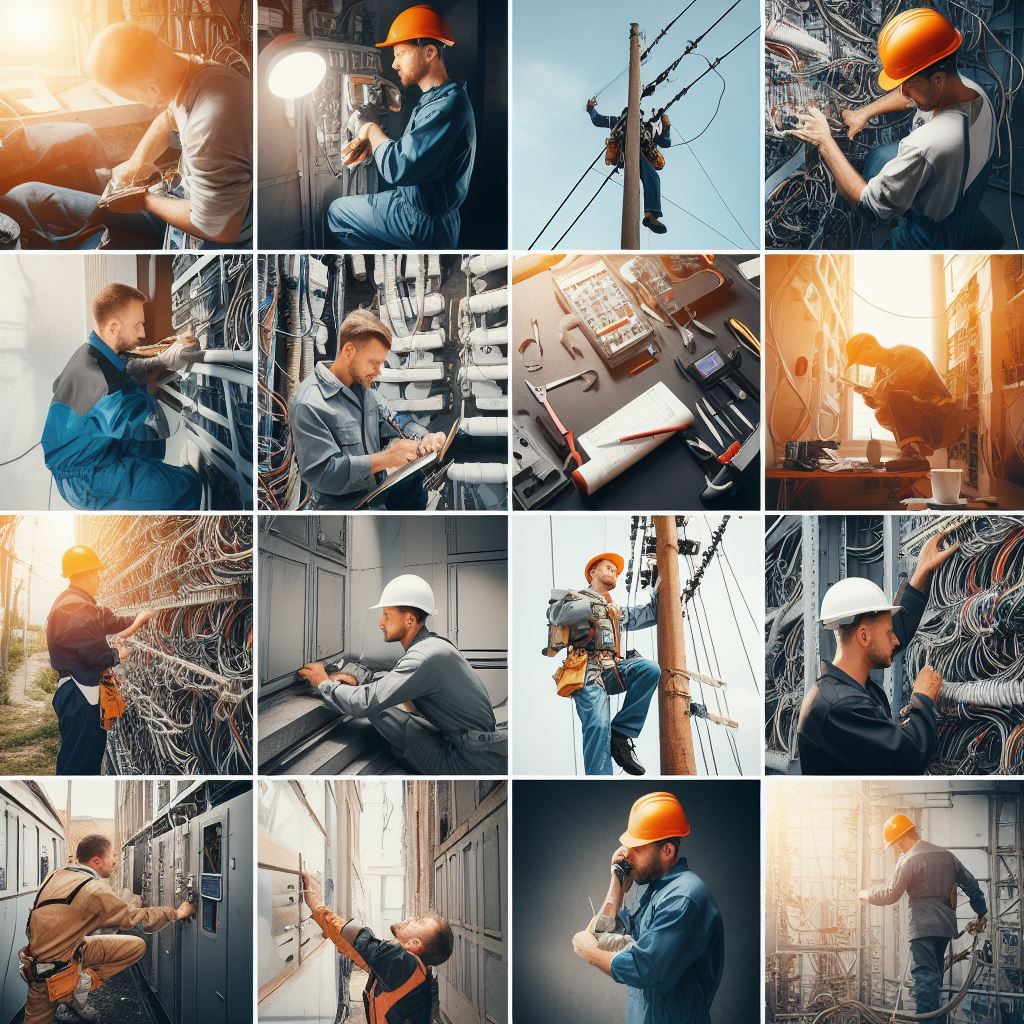Introduction
A Green Electrician can be defined as an electrical professional who prioritizes eco-friendly practices in their work.
They understand the importance of reducing environmental impact and strive to implement sustainable solutions within the electrical industry.
The electrical industry plays a significant role in our daily lives, but it also has a significant environmental impact.
Eco-friendly practices are essential in this industry because they help decrease carbon emissions, conserve resources, and minimize waste.
One of the key benefits of eco-friendly practices for Green Electricians is the reduction of carbon emissions.
By adopting renewable energy sources and energy-efficient technologies, they can help combat climate change and contribute to a more sustainable future.
Moreover, eco-friendly practices help conserve resources.
Green Electricians can promote energy conservation by encouraging clients to opt for energy-efficient appliances, lighting systems, and electrical solutions.
These practices result in reduced energy consumption, lower utility bills, and a more sustainable use of resources.
Additionally, minimizing waste is crucial in the electrical industry.
Green Electricians can explore methods to reduce electrical waste and properly dispose of hazardous materials.
Recycling and reusing electrical components not only reduce the strain on natural resources but also prevent potentially harmful substances from polluting the environment.
In short, being a Green Electrician involves incorporating eco-friendly practices in the electrical industry.
These practices contribute to the reduction of carbon emissions, conserve resources, and minimize waste.
Embracing sustainability is essential for creating a better future for both the electrical industry and the planet.
Energy Conservation
Achieving energy conservation is a crucial aspect of being a green electrician.
By adopting the following practices, electricians can help reduce energy consumption and promote a sustainable future:
Use of energy-efficient appliances and equipment
- Install energy-efficient lighting fixtures, such as LEDs or CFLs, to minimize electricity usage.
- Evaluate and recommend energy-saving appliances to clients, such as refrigerators, air conditioners, and water heaters.
- Advise clients on the benefits of energy-efficient equipment and how it can contribute to long-term energy savings.
Proper insulation and weather sealing techniques
- Ensure that residential and commercial buildings are properly insulated to prevent energy loss.
- Conduct energy audits to identify areas with poor insulation and recommend appropriate solutions.
- Seal windows and doors properly to prevent drafts and maintain optimal indoor temperatures.
Maximizing natural lighting and ventilation in residential and commercial buildings
- Promote the use of daylight by installing skylights, large windows, or light tubes.
- Suggest light-colored paint for walls and ceilings to enhance natural light reflection.
- Install energy-efficient blinds or shades to control sunlight and reduce strain on cooling systems.
- Encourage cross-ventilation by strategically placing windows or using energy-efficient fans.
By employing these strategies, electricians can significantly contribute to energy conservation efforts and minimize their environmental impact.
Clients who actively participate in these eco-friendly practices will not only save money but also contribute to a cleaner and more sustainable world for future generations.
Read: Balancing Work & Life: An Electrician’s Perspective
Transform Your Career Today
Unlock a personalized career strategy that drives real results. Get tailored advice and a roadmap designed just for you.
Start NowRenewable Energy Sources
A green electrician plays a crucial role in promoting sustainable solutions through the efficient utilization of renewable energy sources.
By focusing on the installation and maintenance of solar panels, integration of wind power systems, and utilizing geothermal energy for heating and cooling, a green electrician can contribute to a greener and more eco-friendly future.
Installation and maintenance of solar panels
Solar panels are a popular choice when it comes to harnessing renewable energy.
As a green electrician, it is essential to have in-depth knowledge and expertise in installing and maintaining solar panels efficiently.
This involves assessing the location, determining the optimal placement for maximum sunlight exposure, and ensuring proper wiring and connection.
It is important to understand different types of solar panels, such as monocrystalline and polycrystalline, and their respective benefits and drawbacks.
By being knowledgeable in solar panel technology, a green electrician can provide valuable advice and guidance to clients, helping them make informed decisions about their renewable energy investments.
Integration of wind power systems
Wind power is another excellent renewable energy source that can be integrated into the electrical grid.
A green electrician can play a vital role in installing and maintaining wind turbines, ensuring optimum energy generation and efficiency.
By understanding the technical aspects of wind power systems, including rotor blades, generator, and power control systems, a green electrician can contribute to the successful implementation of wind energy projects.
An effective integration of wind power involves careful planning and coordination to determine the ideal turbine placement and adjust them to the prevailing wind patterns.
Additionally, maintenance tasks, such as inspecting and repairing wind turbines, should be carried out regularly to ensure optimal performance and prolong their lifespan.
Utilizing geothermal energy for heating and cooling
Geothermal energy offers a sustainable solution for heating and cooling systems.
As a green electrician, it is crucial to understand geothermal heat pump technology and its application in residential and commercial buildings.
By utilizing the natural heat from the earth, geothermal systems can provide efficient heating during winter and cooling during summer.
A green electrician can assist in the design and installation of geothermal heat pump systems, including ground source heat pumps and direct exchange systems.
It requires expertise in heat transfer, refrigeration, and electrical connections to ensure the optimal functioning of geothermal systems.
By embracing geothermal energy, a green electrician can significantly contribute to reducing carbon emissions and promoting energy efficiency.
In essence, a green electrician plays a vital role in promoting eco-friendly practices through the utilization of renewable energy sources.
Showcase Your Business Today
Reach thousands of readers actively exploring professional services. Publish your business profile and grow your audience now.
Publish NowBy specializing in the installation and maintenance of solar panels, integration of wind power systems, and utilizing geothermal energy for heating and cooling, a green electrician can contribute to a greener and more sustainable future.
Read: Continuing Education: Advancing Your Electrician Career
Waste Reduction and Recycling
Proper disposal of hazardous electrical materials
- Ensure that hazardous electrical materials are disposed of in accordance with environmental regulations.
- Use designated containers for storing and disposing of hazardous materials.
- Train employees on the proper handling and disposal of hazardous materials.
- Regularly inspect and maintain containers to prevent leaks and spills.
Recycling of old electrical devices and components
- Implement a system for collecting and recycling old electrical devices.
- Partner with certified recycling companies to ensure proper recycling practices.
- Encourage customers to return old devices for recycling by offering incentives.
- Separate different components of the devices to maximize recycling efficiency.
Implementation of paperless processes and digital documentation
- Transition from paper-based processes to digital platforms for documentation.
- Invest in software and equipment that facilitate digital documentation.
- Train employees on using digital tools and storing documents electronically.
- Promote the use of electronic communication to minimize paper usage.
By incorporating waste reduction and recycling practices, today’s green electricians can contribute to a more sustainable future.
Reducing waste and properly disposing of hazardous materials is crucial for minimizing environmental impact.
Green electricians should ensure that hazardous electrical materials are handled and disposed of in compliance with environmental regulations.
This involves using designated containers specifically designed for storing and disposing of hazardous materials.
Furthermore, employees should receive proper training on how to handle and dispose of these materials safely.
Regular inspections and maintenance of storage containers should also be conducted to detect any leaks or spills that could harm the environment.
Recycling old electrical devices and components is another important practice for eco-friendly electricians.
Implementing a system for collecting and recycling old devices can help prevent them from ending up in landfills.
Green electricians should partner with certified recycling companies to ensure that the recycling process meets environmental standards.
To encourage customers to return their old devices, offering incentives such as discounts or trade-in programs can be effective.
Additionally, separating different components of the devices before recycling can maximize the efficiency of the recycling process.
Implementing paperless processes and digital documentation can significantly reduce paper waste.
Green electricians should transition from traditional paper-based processes to digital platforms for documentation.
This may require investing in software and equipment that facilitate the transition.
Employees must be trained on how to use digital tools and store documents electronically.
Additionally, promoting the use of electronic communication, such as email or online messaging, can minimize paper usage while maintaining efficient communication within the team.
Basically, waste reduction and recycling practices are essential for today’s green electricians.
Proactively disposing of hazardous electrical materials, recycling old devices, and implementing paperless processes can greatly contribute to a more sustainable and environmentally friendly electrical industry.
Read: Spotlight: Women in the Electrician Profession

Water Conservation
Promoting the use of low-flow faucets and showerheads
Installing efficient irrigation systems
Educating clients on the importance of water-saving practices
Water is a precious resource, and as an eco-friendly electrician, it is important to prioritize water conservation in your practices.
By promoting the use of low-flow faucets and showerheads, you can help your clients reduce their water consumption and minimize waste.
Installing efficient irrigation systems is another way to conserve water.
By using technology such as smart irrigation controllers and drip systems, you can ensure that water is used efficiently in landscaping projects.
This not only saves water but also helps maintain healthier plants and reduces the need for chemical fertilizers.
Educating your clients on the importance of water-saving practices is crucial.
Many people are unaware of the significant impact their daily habits can have on water resources.
By explaining the benefits of water conservation and providing practical tips, you can inspire them to make conscious choices and contribute to a more sustainable future.
Here are some specific actions you can take:
Promoting the use of low-flow faucets and showerheads
- Advise your clients to replace their old faucets and showerheads with low-flow alternatives.
- Explain that these fixtures can significantly reduce water consumption without compromising water pressure.
- Mention that low-flow faucets and showerheads are often available in stylish designs, ensuring that clients do not have to compromise on aesthetics.
Installing efficient irrigation systems
- Offer your clients the option of installing smart irrigation controllers.
- Explain that these controllers use weather data and soil moisture sensors to optimize watering schedules, resulting in minimal water wastage.
- Suggest using drip irrigation systems for gardens and landscapes, as they deliver water directly to plant roots, minimizing evaporation and runoff.
Educating clients on the importance of water-saving practices
- Host workshops or seminars to provide information on water conservation.
- Highlight the environmental impact of excessive water usage and the benefits of adopting water-saving habits.
- Share simple tips like taking shorter showers, fixing leaks promptly, and watering plants during cooler parts of the day.
Remember, as a green electrician, your role extends beyond electrical systems.
By integrating water-saving practices into your work, you can make a significant contribution to preserving this valuable resource.
Read: The Future of Electric Work: Trends & Predictions
Indoor Air Quality Improvement
Achieving good indoor air quality is essential for maintaining a healthy and comfortable environment.
As a green electrician, you can contribute to this by implementing various eco-friendly practices.
Use of VOC-free paints and adhesives
One way to improve indoor air quality is by using paints and adhesives that are free from volatile organic compounds (VOCs).
VOCs are chemicals that can emit harmful pollutants into the air, leading to respiratory problems and other health issues.
Showcase Your Business Today
Reach thousands of readers actively exploring professional services. Publish your business profile and grow your audience now.
Publish NowBy choosing VOC-free products, you can help reduce indoor air pollution, creating a safer and healthier space for your clients.
Look for paints and adhesives with low VOC content or those that are labeled as eco-friendly or green.
Installation of high-quality air filters and purification systems
Another effective strategy to enhance indoor air quality is by installing high-quality air filters and purification systems.
These devices can efficiently remove airborne pollutants, such as dust, allergens, and volatile organic compounds.
Ensure that the air filters you install have a high MERV (Minimum Efficiency Reporting Value) rating.
This rating indicates the filter’s effectiveness in capturing and trapping particles of different sizes.
Opt for filters with MERV ratings of 7 or higher for superior air filtration.
Consider suggesting the installation of air purification systems that use advanced technologies like HEPA (High-Efficiency Particulate Air) filters or activated carbon filters.
These systems can effectively eliminate even the smallest particles and odor-causing compounds present in the air.
Maintenance of proper ventilation to prevent air stagnation
Proper ventilation is crucial in preventing air stagnation and maintaining good indoor air quality.
Encourage your clients to take measures to ensure adequate air circulation in their buildings.
Advise them to regularly clean and maintain their HVAC (Heating, Ventilation, and Air Conditioning) systems.
Dust and debris build-up in these systems can hinder proper airflow and contribute to the accumulation of indoor air pollutants.
Additionally, suggest the installation of mechanical ventilation systems, such as exhaust fans or air exchangers, in areas prone to excess moisture, like bathrooms and kitchens.
These systems help remove damp air and reduce the risk of mold growth and indoor air pollution.
Advocate for the use of natural ventilation whenever possible.
Encourage your clients to open windows and doors to let in fresh air and promote cross ventilation.
This simple practice can significantly improve indoor air quality without the need for additional energy consumption.
As a green electrician, you play a vital role in promoting eco-friendly practices for indoor air quality improvement.
By using VOC-free paints and adhesives, installing high-quality air filters and purification systems, and ensuring proper ventilation, you can create healthier and more sustainable living environments for your clients.
Responsible Worksite Management
A green electrician not only focuses on eco-friendly electrical practices but also ensures responsible worksite management.
By minimizing construction waste and debris, properly storing and disposing of construction materials, and following eco-friendly construction practices and codes, a green electrician contributes to a sustainable environment.
Minimizing Construction Waste and Debris
- Implement a waste management plan to reduce the amount of construction waste generated on the worksite.
- Separate recyclable materials, such as metal and wires, from other waste to facilitate recycling.
- Encourage the reuse of materials whenever possible to minimize waste and reduce the consumption of new resources.
- Properly dispose of hazardous materials, such as lead-based paint or asbestos, following appropriate guidelines and regulations.
- Regularly clean the worksite to prevent debris from accumulating and polluting the surrounding ecosystem.
Proper Storage and Disposal of Construction Materials
- Store construction materials in a designated area to avoid damage and ensure easy accessibility.
- Securely cover and protect materials stored outdoors to prevent weather damage and contamination.
- Avoid excessive stockpiling of materials to minimize waste and unnecessary consumption.
- Dispose of unused or excess materials responsibly, whether through donation or proper recycling methods.
- Follow local regulations and guidelines for hazardous material disposal to prevent environmental pollution.
Following Eco-friendly Construction Practices and Codes
- Familiarize yourself with green building practices and codes to ensure compliance throughout the construction process.
- Opt for energy-efficient electrical systems, such as LED lighting or smart thermostats, to minimize energy consumption.
- Install renewable energy systems, like solar panels or wind turbines, to produce clean and sustainable electricity.
- Use low VOC (Volatile Organic Compounds) paints, adhesives, and sealants to minimize indoor air pollution.
- Incorporate insulation and proper air sealing techniques to enhance energy efficiency and reduce heating and cooling demands.
Responsible worksite management is an essential aspect of being a green electrician.
By minimizing construction waste and debris, properly storing and disposing of construction materials, and following eco-friendly construction practices and codes, a green electrician not only promotes sustainability but also ensures a healthier environment for future generations.
Collaboration and Education
Participation in green certification programs and associations
- Joining green certification programs such as LEED or Green Advantage can validate the electrician’s eco-friendly practices.
- Collaborating with other green electricians through associations like the Sustainable Energy Association can foster knowledge sharing and support.
- Attending conferences and seminars organized by these programs and associations can enhance technical skills and understanding of sustainable practices.
Continuous professional development on eco-friendly practices
- Staying updated with the latest advancements and regulations in green technology is essential for a green electrician.
- Participating in workshops and training sessions that focus on eco-friendly practices helps electricians improve their expertise.
- Engaging in online courses and webinars can provide convenient opportunities for continuing education.
Educating clients on the benefits of green electrical solutions
- Communicating with clients about the positive impacts of choosing green electrical solutions can raise awareness and encourage their adoption.
- Explaining the energy efficiency and cost savings associated with eco-friendly practices can help clients make informed decisions.
- Providing educational materials, such as brochures or handouts, can serve as valuable resources for clients who want to learn more.
- Offering consultations and discussing specific sustainable options tailored to the client’s needs can foster trust and satisfaction.
- Promoting the long-term benefits and positive environmental impact of green electrical solutions can create a positive reputation for the electrician.
Conclusion
To recap, green electricians can implement several eco-friendly practices, such as
- Using energy-efficient lighting and appliances
- Installing solar panels to harness renewable energy
- Properly disposing of hazardous materials
- Promoting energy conservation and efficient electrical systems
It is important for all electricians to adopt sustainable practices and contribute to a greener future.
By implementing eco-friendly practices, electricians can positively impact the environment and society by reducing carbon emissions, conserving resources, and promoting a healthier lifestyle.
[E-Books for Sale]
The Big Book of 500 High-Paying Jobs in America: Unlock Your Earning Potential
$19.99 • 500 High-Paying Jobs • 330 pages
Explore 500 high-paying jobs in America and learn how to boost your career, earn more, and achieve success!
See All 500 High-Paying Jobs of this E-Book
1001 Professions Without a Degree: High-Paying American Jobs You Can Start Now
$19.99 • 1001 Professions Without a Degree • 174 pages
Discover 1001 high-paying jobs without a degree! Unlock career tips, skills, and success strategies for just $19.99!




